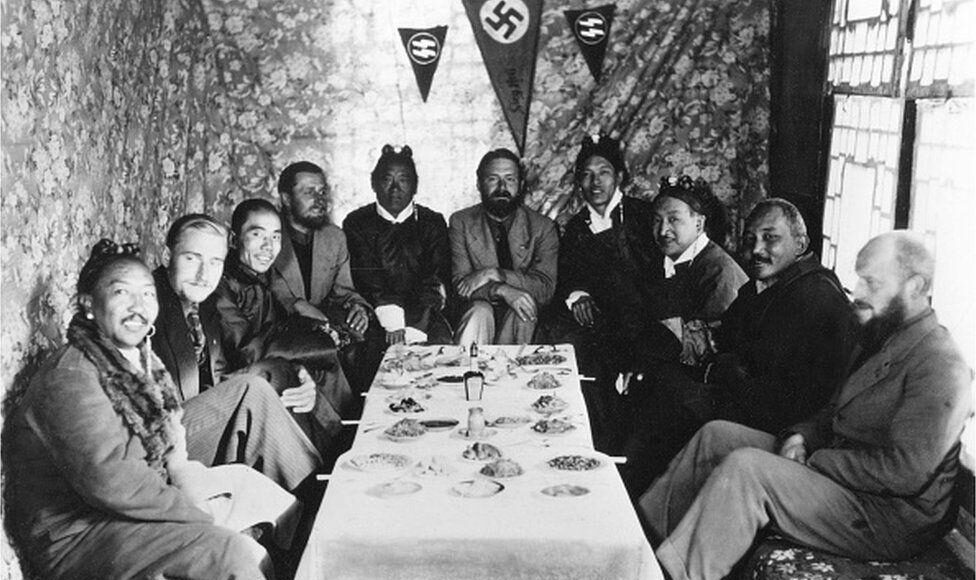In 1938, Heinrich Himmler, a leading member of Germany’s Nazi party and a key architect of the Holocaust, sent a five-member team to Tibet to search for the origins of the supposed Aryan race. Author Vaibhav Purandare recounts the fascinating story of this expedition, which passed through India.
A little over a year before World War Two began, a group of Germans landed surreptitiously along India’s eastern borders.
They were on a mission to discover the “source of origin of the Aryan race”.
Adolf Hitler believed that “Aryan” Nordic people had entered India from the north some 1,500 years earlier, and that the Aryans had committed the “crime” of mixing with the local “un-Aryan” people, losing the attributes that had made them racially superior to all other people on earth.
Hitler regularly expressed deep antipathy for the Indian people and their struggle for freedom, articulating his sentiments in his speeches, writings and debates.
Yet, according to Himmler, one of Hitler’s top lieutenants and the head of the SS, the Indian subcontinent was still worth a close look.
This is where Tibet came into the picture.
Those who swore by the idea of a white Nordic superior race were believers in the tale of the imagined lost city of Atlantis, where people of “the purest blood” had apparently once lived. Believed to have been situated somewhere between England and Portugal in the Atlantic Ocean, this mythical island allegedly sunk after being struck by a divine thunderbolt.
All the Aryans who survived had supposedly moved on to more secure places. The Himalayan region was believed to be one such refuge, Tibet in particular because it was famous for being “the roof of the world”.
In 1935, Himmler set up a unit within the SS called the Ahnenerbe – or Bureau of Ancestral Heritage – to find out where people from Atlantis had gone after the bolt from the blue and the deluge, and where traces of the great race still remained and could be discovered.
In 1938, he sent a team of five Germans to Tibet on this “search operation”.
Two of the team’s members stood out from the rest. One was Ernst Schafer, a gifted 28-year-old zoologist who had been to the India-China-Tibet border twice earlier. Schafer had joined the SS soon after the Nazi triumph of 1933, long before Himmler became his patron for the Tibet expedition.
Schafer was crazy about hunting and loved to gather trophies in his Berlin home. On one hunting expedition, while attempting to shoot a duck from a boat he and his wife were in, he slipped when taking aim and shot his wife in the head accidentally, killing her.
The second key man was Bruno Beger, a young anthropologist who had joined the SS in 1935. Beger would take measurements of the skulls and facial details of Tibetans and make face masks, he said, “especially to collect material about the proportions, origins, significance and development of the Nordic race in this region”.
The ship carrying the five Germans docked at Colombo in Sri Lanka early in May 1938. From there, they took another one to Madras (now Chennai) and a third one to Calcutta (now Kolkata).
British authorities in India were wary of the travelling Germans and thought them spies. They were initially reluctant to allow them to pass through India and the then British-run Times of India even ran the accusatory headline: “A Gestapo Agent in India”.
The British political officer in Gangtok, in the north-eastern Indian state of Sikkim, which was an independent mountain kingdom at the time, was also not enthusiastic about granting the men entry into Tibet through Sikkim.
But ultimately, the Nazi team’s resolve won. By the end of the year, the five Germans, with swastika flags tied to their mules and baggage, had entered Tibet.
The swastika was a ubiquitous sign in Tibet, known locally as “yungdrung”. Schafer and the team would have seen plenty of it during their time in India too where, among Hindus, it had long been a symbol of good fortune. Even today, the symbol is visible outside homes, inside temples, at street corners and on the backs of tempos and trucks.
In Tibet, meanwhile, things were changing.
The 13th Dalai Lama had died in 1933 and the new one was only three years old, so the Buddhist Tibetan kingdom was being controlled by a regent. The Germans were treated exceptionally well by the regent as well as by common Tibetans, and Beger, who made face masks, even acted as a sort of stand-in doctor for locals for a while.
What the Tibetan Buddhists did not know was that in the perverse imagination of the Nazis, Buddhism, just like Hinduism, was a religion that had weakened the Aryans who had come to Tibet – and had resulted in the loss of their spirit and strength.
Just when it appeared that Schafer and the others could spend more time exploring for their real “research” in the guise of carrying out scientific investigations in areas such as zoology and anthropology, the German expedition was abruptly cut short in August 1939 by the inevitability of the war.
Beger had, by then, measured the skulls and features of 376 Tibetans, taken 2,000 photographs, “made casts of heads, faces, hands and ears of 17 people” and collected “the finger and hand prints of another 350”.
He had also gathered 2,000 “ethnographic artefacts”, and another member of the contingent had taken 18,000 metres of black-and-white film and 40,000 photographs.
As their trip was cut short, Himmler made arrangements for the team to fly out of Calcutta at the last moment and was himself present to greet them when their plane landed in Munich.
Schafer took most of his Tibetan “treasures” to a castle in Salzburg he moved to during the war. But once the Allied Forces came in 1945, the place was raided and most of the Tibetan pictures and other material were ruined.
The other so-called “scientific results” of the expedition met the same fate in the war: they were either lost or destroyed, and the shame of the Nazi past meant no-one after the war tried to trace the material.
Vaibhav Purandare is the author of Hitler And India: The Untold Story of His Hatred For the Country And Its People, published by Westland Books











